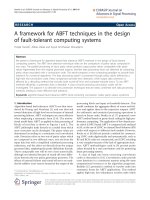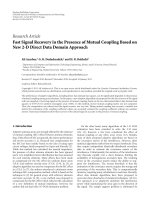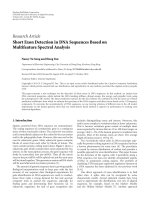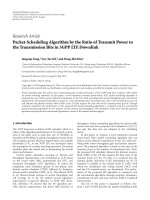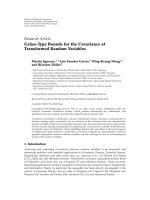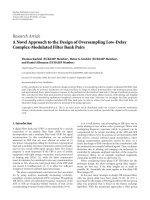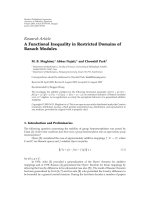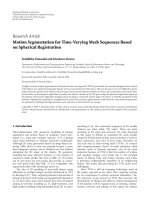Báo cáo hóa học: "Research Article Reconfiguration Management in the Context of RTOS-Based HW/SW Embedded Systems" potx
Bạn đang xem bản rút gọn của tài liệu. Xem và tải ngay bản đầy đủ của tài liệu tại đây (905.26 KB, 10 trang )
Hindawi Publishing Corporation
EURASIP Journal on Embedded Systems
Volume 2008, Article ID 285160, 10 pages
doi:10.1155/2008/285160
Research Article
Reconfiguration Management in the Context of
RTOS-Based HW/SW E mbedded Systems
Yvan Eustache and Jean-Philippe Diguet
LESTER Lab, CNRS/UBS, 56100 Lorient, France
Correspondence should be addressed to Yvan Eustache,
Received 1 April 2007; Revised 24 August 2007; Accepted 19 October 2007
Recommended by Alfons Crespo
This paper presents a safe and efficient solution to manage asynchronous configurations of dynamically reconfigurable systems-
on-chip. We first define our unified RTOS-based framework for HW/SW task communication and configuration management.
Then three issues are discussed and solutions are given: the formalization of configuration space modeling including its different
dimensions, the synchronization of configuration that mainly addresses the question of task configuration ordering, and the con-
figuration coherency that solves the way a task accepts a new configuration. Finally, we present the global method and give some
implementation figures from a smart camera case study.
Copyright © 2008 Y. Eustache and J P. Diguet. This is an open access article distributed under the Creative Commons Attribution
License, which permits unrestricted use, distribution, and reproduction in any medium, provided the original work is properly
cited.
1. INTRODUCTION
1.1. Self-adaptive RTOS-controlled SoC
Upcoming embedded systems will implement complex mul-
tistandard multimode applications competing for resources
within a heterogeneous architecture. One of the most impor-
tant challenges in this context is the tradeoff between flexi-
bility needed for fast design of mass products, performance,
power management, and quality of service (QoS). This trade-
off can only be partially obtained at design time. CPU and
communication loads vary with tasks’ changeable execution
times. This can be due to network access conditions, data val-
ues, architecture hazards (e.g., cache miss), or user choices.
One of the most promising directions to deal with such
constraints is the reconfigurable architecture that can be
tuned accordingly to resource requirements.
Embedded systems, in the domain of wireless networks
and multimedia applications, manage concurrent applica-
tions with fluctuating loads. It means that reconfiguration re-
quests are not usually synchronized with running tasks and
can happen at any time independently of data and control
flows of concurrent applications. In such a context, one of the
main tedious problems is to guarantee a safe reconfiguration
synchronization that takes care of data dependencies and al-
gorithm coherency. The resulting complexity of the system
control requires RTOS services for synchronization, commu-
nication, and concurrency management. In addition to that,
extensions of RTOS services are needed for configuration
management in order to provide two kinds of capabilities: (i)
transparent hardware and software communication services
and (ii) configuration management in order to facilitate the
design of complex heterogeneous systems. Another impor-
tant RTOS advantage is the abstraction to increase portability
and to facilitate reuse of code and repartitioning.
The objective of this work is to formalize and implement
an abstraction layer suitable for usual RTOS in order to han-
dle hardware and software communications and configura-
tion management. In our experiments, we use μ COSII which
is implemented on different targets such as NIOS, PowerPC,
and MicroBlaze cores on Altera and Xilinx devices, respec-
tively.
The background of this paper is our solution for imple-
menting self-adaptive systems. The foreground is the tedious
question of configuration switching in the context of hard-
ware and software implementations. This point is generally
simplified, whereas it raises in practice complex questions
about configuration granularity and synchronization.
The rest of the paper is organized as follows. Section 2
provides a description of our adaptive system model in-
cluding the HW/SW unified interface and the configuration
model. In Section 3, we present the main issues and solutions
2 EURASIP Journal on Embedded Systems
involved with the reconfiguration and propose the new con-
cept of configuration granularity to manage a coherent con-
figuration. Finally, a smart camera case study is introduced
in Section 4 to validate our approach.
1.2. Related works
In this section, we survey a selection of related works in
the area of RTOS-based reconfigurable SoC. Firstly a lot of
work has been produced in the domain of adaptive archi-
tectures. Different techniques have been introduced for clock
and voltage scaling [1], cache resources [2], and functional
units [3] allocations. These approaches can be classified in
the category of local configurations based on specific aspects.
Our aim is to add global configuration management includ-
ing both algorithmic and architectural aspects.
Secondly RTOS for HW management has been recently
introduced. Proofs of concepts are exhibited in [4, 5]. These
experiments show that RTOS level management of recon-
figurable architectures can be considered as being available
from a research perspective. In [5], the RTOS is mainly ded-
icated to the management (placement/communication) of
HW tasks. Run-time scheduling and 1D and 2D placement of
HW tasks’ algorithms are described in [6]. In [4], the OS4RS
layer is an OS extension that abstracts the task implementa-
tion in hardware or software; the main contribution of this
work is the communication API based on message passing
where communication between HW and SW tasks is han-
dled with a hardware abstraction layer. Moreover, the het-
erogeneous context switch issue is solved by defining switch-
ing points in the data flow graph, but no computation details
are given. In [7], abstraction of the CPU/FPGA component
boundary is supported by HW thread interface concept, and
specific RTOS services are implemented in HW. In [8], more
details are given about a network-on-chip communication
scheme.
The current state of the art shows that adaptive, recon-
figurable, and programmable architectures are already avail-
able, but there is no real complete solution proposed to guar-
antee safe configuration management. Some concepts are
presented but no systematic solutions are proposed.
2. ADAPTIVE SYSTEM MODEL
2.1. System model
The targeted system is a multitask heterogeneous system
composed by an embedded processor for the SW tasks
and accelerators implementing HW tasks; both are masters
on a communication medium, which is a shared bus or
a network-on-chip. Such a system improves performances
since several data-dependent or independent tasks can
run concurrently. Communication between data-dependent
tasks is based on shared memories for data and RTOS mes-
sage passing services for events and address notification (e.g.,
mailbox and message queue). Data-dependent tasks are gath-
ered in a cluster; each cluster can have one or more source
tasks and sink tasks; a minimum cluster is reduced to a single
UCCI
Slave port
IRQ
FSM
DMA
Reg.
bank
Local
HAL
HW core
Master port
Te s t s c o n fi g .
Wai ts co nfig.
HW?
SW
process
HW
legal
representative
Evaluates metric
Sends metric
Figure 1: Unified communication and configuration interface.
task. At the highest level, applications can be composed by
several clusters.
We define the model of the system as a directed acyclic
graph where a task is represented by a node and the shared
memory by an edge connecting two nodes (details are given
in Section 3.3.3).
2.2. UCCI concept
2.2.1. OS services access for HW tasks
Abstract HW/SW interface for an embedded system-on-chip
is an important topic. It allows communications between
tasks independently of their implementations. In our adap-
tive strategy, communications are not limited to data since
local data (task context: recursive data, counters), config-
uration (pointers, configuration ID), and metrics are also
exchanged. Thus, task communications are encapsulated
within a unified interface called UCCI (see Figure 1) that
handles configuration, data, and control communications in
such a way that usual SW and HW implementations can be
directly instantiated in the new framework.
Each HW task has a legal representative (LR) which is
a lightweight SW task that maintains communications be-
tween RTOS and tasks implemented in hardware. Local data
can be read (resp., written) by the LR in case of HW to SW
(resp., SW to HW) migration or by the HW UCCI in case of
HW to HW migration. Basically, a context transfer is equiv-
alent to a data transfer performed between reconfigurations
in case of HW to SW or HW to HW migrations.
The UCCI implementation imposes some constraints re-
garding I/O format. For instance, local data are based on
identical stacks for all HW and SW versions. Moreover, some
SW routines have been added for data format adaptation; the
more used one is the bit/byte conversion routine required
when SW tasks accede to binary images where pixel is coded
as bit for bandwidth and area optimization.
2.2.2. Tasks communication
Communications with an SW task are involved to call the
intertask communication RTOS services. Two kinds of oper-
ation can be used: post and pend communications. For SW
→ SW communications, traditional communication services
are used, whereas in HW
↔SW communications, the LR task
Y. Eustache and J P. Diguet 3
Architecture
configuration
Dataflow
configuration
Algorithm
configuration
UCCI
Core
T
1
SW T
3
T
5
SW
T
2
T
4
SW
T
2
T
3
T
2
HW
T
4
T
1
T
1
Communication
media
Figure 2: Configuration space model.
is mainly used to handle the HW pend request. Postservices
are supported directly by the interrupt service routine (ISR).
If using RTOS communication services appears to be essen-
tial to abstract the communication between tasks, the over-
head due to the HW to LR communication via the ISR and
the involved context switches can be important for an appli-
cation using mainly message passing. Communication over-
head between two HW tasks via RTOS communication ser-
vice has been drastically reduced while delegating post and
pend communication management to HW UCCI which pro-
vides message passing services. Thus, a first task can write di-
rectly the message in a specific register of a second HW task.
“Pend” is represented by a wait state until a message is writ-
ten in the register. Other services such as mutex, semaphore,
and flag services are provided by the RTOS and not imple-
mented in UCCI since no distributed implementation was
justified. However, independently of our work, some specific
HW implementations of mutex, for instance, can be added
to improve performances as shown in [9].
UCCI concept brings efficient communication between
HW tasks. However, control is added to the HW task to man-
age direct or OS message passing according to the implemen-
tation of the other tasks (more details are given in [10]).
2.3. Configuration space modeling
Based on our analysis, we propose to partition the configu-
ration space into three levels (see Figure 2).
Algorithm reconfiguration targets the functionality of a
task. A new configuration may occur to improve perfor-
mance, QoS, or energy. In this paper, we consider that each
configurable task implements different algorithms with var-
ious complexity/performance tradeoffs; it can be, for in-
stance, different lowpass filters based on an average of a vari-
able number of images (2, 3, 4), image processing based on
various mask sizes, or image thresholding based on static or
dynamic thresholds.
Data flow reconfiguration represents the intertask com-
munication scheme at the application level. The data flow
configuration mainly impacts task UCCI and principally
communication parameters (read/write addresses) located in
the HAL. Such a configuration is used, for instance, when
a task is inserted in or removed from the application. Since
data flow and algorithm modifications are very close in terms
of frequency and management, we gather these two kinds of
configurations under the term of algorithm configuration in
the rest of the paper.
Architecture configuration is the arrangement of HW and
SW task implementations for a set of tasks with associated
selected algorithms. Architecture reconfiguration may occur
tomigrateanSWtasktoanHWimplementation.Inopposi-
tion, the system may switch a task from HW to SW. However,
this possibility of task migration leads to important time and
resource overheads (HW
↔SW context store/load, bitstream
generation, and download). In consequence, the modifica-
tion of an architecture cannot occur at the application fre-
quency. A tradeoff has to be solved between the rate of ar-
chitecture reconfiguration and the gain it brings. We assume
that HW dynamic configuration is available, but we do not
address this point which is very technology-dependent (e.g.,
Xilinx bitstream loading). Besides, we have implemented our
smart camera prototype on an Altera StratixII FPGA, which
does not allow for dynamic reconfiguration; so all tasks are
implemented at design time. Thus, HW task activation is im-
plemented with a clock gating control.
Finally, reconfiguration raises the questions of algo-
rithm/architecture selection, task activation control, com-
munication scheme setup, and HW clock management. So,
a configuration can be modeled by a unique configura-
tion identifier (CID), which represents a point in a three-
dimensional space, namely, the combination of a set of al-
gorithms, a data flow, and an architecture.
2.4. Configuration management
2.4.1. Of/online configuration management
Embedded systems are characterized by scarce resources in
terms of energy, memory, and processing to be used effi-
ciently. Our low-cost configuration management reduces the
time and memory overheads separating offline selection and
adaptation at run time. The first step of the management is
the offline selection of potential configurations. The space of
configuration (algorithm, data flow, and architecture config-
urations) is reduced to a unit of best configurations, in terms
of performance, consumption, and QoS. An incertitude due
to environment fluctuations or internal risks (cache misses,
bus collisions, etc.) is also taken into account. In addition,
the system adapts itself to its configuration by selecting on-
line the best configuration within the preselected configura-
tion finite space. Thus, no generation of configuration is pro-
cessed and adaptation time is minimized.
2.4.2. Local/global separation of concerns
Online adaptation issue encompasses different aspects that
drive the implementation of the reconfiguration decision
control. The first relevant point is locality. A reconfiguration
can be decided at the application level or system level. Based
on application-specific data, a local decision provides a short
reaction delay and metrics to compute the QoS. However,
some decisions must be considered globally when a tradeoff
4 EURASIP Journal on Embedded Systems
Generic
(system)
Specific
(application)
Selects the next configuration
Gas gauge
Exec. time (OS)
Appli. 1
QoS
T
0
T
1
T
2
T
3
T
5
T
6
T
7
GCM
LCM
LCM
Metrics Configure each task
Restricts the
solution space
Figure 3: Application versus system configuration management.
has to be found over the complete system between power
consumption and computation efficiency. Another pertinent
point is the complexity of the decision implementation. In
the context of embedded systems, only low-cost solutions
must be considered. To cope with these issues, we imple-
ment a two-step configuration management (see Figure 3).
The local configuration manager (LCM) is the first level; it
is application-specific. The second one is the global configu-
ration manager (GCM); it is generic and so independent of
embedded applications.
LCM is in charge of the algorithm configuration for all
the tasks of the application it controls. Given results from
application tasks, it first transforms application-specific met-
rics into normalized QoS metrics for the GCM. This is a kind
of “application sensors” for the global manager. Secondly, it
selects the minimum algorithm configuration to be consid-
ered by the GCM. Finally, the LCM controls the application
configuration while applying the GCM decisions.
GCMisinchargeofglobalsystemparameters(e.g.,I/O
data rates) and HW/SW implementation decisions. It collects
information for configuration decisions from sensors such
as CPU load from the OS, application-specific QoS from
LCMs, and battery level and power from the gas gauge con-
troller or from estimators when no measures are available.
The GCM decides upon the new system configuration ac-
cording to user requirements (system references) and con-
figuration solutions issued from the local managers’ design
space restrictions.
LCM and GCM as new RTOS services
LCM is application-specific; it can be interpreted as a kind of
driver or abstraction layer to get algorithmic configuration
wishes issued from application tasks and to send new config-
urations to application tasks. A GCM is a new RTOS service
comparable to scheduling or resource allocation.
In practice, LCM and GCM can be implemented as high-
priority tasks within an existing RTOS (e.g., μCos). In such
a scheme, each LCM pends on a message queue where appli-
cation metrics are loaded and reacts according to its config-
uration management policy. The GCM wakes up each time a
configuration algorithm is notified and reacts according to its
configuration management policy. A simple policy consists
in waiting all notifications from application tasks or LCM,
Configuration
Time
Architecture 2
Architecture 1
Algorithm 1
Algorithm 3
Algorithm 4
Algorithm 1
Algorithm 2
Algorithm 3
C
k
C
k
C
i
C
j
T appli
-Metrics (LCM)
-QoS
-Performance
T
battery
Sensors
Decision
T
GCM appli T GCM archi
Figure 4: Configuration management timing.
and it decides upon the new configuration compliant with
user requirements.
2.4.3. Configuration management timing
Configuration frequency is also an important issue regard-
ing configuration overhead. As shown in Figure 4, applica-
tion execution time is defined as the base period; after each
execution, the LCM receives metrics from tasks and collects
QoS and execution time. Sensors acquisition (e.g., battery
level) is managed with lower frequencies and can use linear
estimators [11] to alleviate the measure overhead. In oppo-
sition, battery sensor, due to its important overhead of re-
sources (control, computation time, consumption), is mon-
itored with a lower frequency. At the application period, the
GCM selects suitable algorithm configuration according to
the actual architecture. The GCM is not synchronized with
LCMs. In case of a single application, its period is the ap-
plication one with an important restriction due to the con-
figuration overhead of current reconfigurable SoC (FPGA).
Thus, when architecture reconfiguration occurs, a provision
period is computed; during this period, the GCM can only
allow algorithmic reconfigurations. This two-step configura-
tion management is very flexible and allows a short reaction
delay for algorithm adaptation compared to the architectural
modification.
3. SYNCHRONIZATION AND COHERENCY
Adaptation process involves three main steps. First, the sys-
tem has to be able to monitor its environment. For exam-
ple, in our smart camera case study, the LCM locally uses the
number of objects and the image resulting noise (number of
isolated white pixels) to configure/select algorithms. More-
over, the LCM provides GCM with the application QoS being
computed as the difference between object position based on
image processing and estimations based on linear extrapola-
tions. Other global information used is the battery level and
task execution times.
Based on this set of information, the system (GCM)
takes a decision (e.g., selection of a more robust 2D low-
pass filter). Finally, it must guarantee a safe transition from
an old to a new configuration. We propose to partition it
into three subissues: local data management, communication
Y. Eustache and J P. Diguet 5
dependencies, and functional dependencies that guarantee
application coherency.
3.1. Issues
Local data management: architectural reconfiguration raises
the question of management of local data. Close to the SW
context switch, HW task preemption involves saving process-
ing data. It allows the task to resume its process with another
implementation (HW/SW switches or HW move) with iden-
tical conditions. The main difficulty is to define a context
model and store/load management.
Communication dependency: the communication topol-
ogy can be modified according to data flow reconfiguration.
So, the reconfiguration may be performed in a particular or-
der compliant with communication dependencies to avoid
memory or mail queue address mismatches. It means that a
sender task will be configured before the task waiting for its
data.
Functional dependency: configuration may also involve
functional coherency management. However, if communica-
tion dependency is a run-time issue, management of func-
tional coherencies can be processed offline. Such a modifi-
cation may affect three process characteristics of a task: the
functionality (e.g., compression/decompression algorithm),
the amount of data (e.g., image size), and the data type
(e.g., bit or byte processing). Thus, it may involve con-
figuration dependencies between communicating tasks. Al-
gorithm modification of configuration-dependent tasks in-
volves defining configuration management to insure coher-
ent data exchanges. On the other side, some algorithm con-
figurations involve no configuration dependencies between
tasks (e.g., the coefficient modification in a filtering task). In
this case, the modification may be accepted at any time.
Finally, the problem of the coherency management
is“how to be sure that a task receives sufficient homogeneous
data from other tasks to complete its process and to provide
sufficient homogeneous data to the downstream tasks before
accepting a reconfiguration.” This issue has to be solved re-
garding the complete system from source to sink tasks of all
clusters and for each configuration.
3.2. Solutions
To solve the issues described above, we mainly target two
points: synchronization which corresponds to the timing or-
der to reconfigure the tasks, and algorithm coherency which
corresponds to the integrity of data exchanged between tasks
being reconfigured.
3.2.1. Local data management
Local data management is a key point in the reconfigurable
HW system research topics and mainly for the preemption
of HW tasks. Usually, it is solved by considering that HW
tasks are not preemptible, and so no context needs to be
saved. Walder et al. target this issue in [12] and indicate that
such services must be included, but no more details are given.
This issue is strongly technology-dependent. In our applica-
tion case study, we define task local data context (LDC) as a
task-specific stack containing resident computation data and
data pointers, which are unique for both HW and SW tasks.
For SW to HW and HW to SW reconfigurations, contexts
can be communicated directly via the LR. Regarding HW to
HW reconfigurations, we use the same scheme as that im-
plemented for data communications: shared memories and
message (addresses) passing. Thus, contexts are saved in a
context memory reloaded after each configuration. LDC is
automatically loaded after a reconfiguration as the initializa-
tion step before running.
3.2.2. Synchronization
Online synchronization issue can be solved with configura-
tion diffusion mechanisms. Our concept is based on the uti-
lization of existing communication channel (direct HW to
HW configuration or with RTOS communication services).
Thus, we define a two-step strategy. Firstly, the configura-
tion manager sends the CID to all source tasks of each cluster
through a multicast diffusion. Secondly, the CID is propa-
gated gradually from the source to the sink tasks over data
channels. More details are given in Section 3.4
With such diffusion principles, we guarantee that all tasks
will be configured starting with the source tasks. Note that
propagation principle increases the HW control. Indeed,
HW tasks receive and send the configuration ID via OS com-
munication services or directly according to the implemen-
tation of other tasks. Moreover, it has also to inform its LR
when it receives directly the CID from an HW task.
3.2.3. Algorithm configuration coherencies
To solve configuration coherency, we introduce the new con-
cept of configuration granularity that guarantees for each
task consistent production of data. For each configuration
and for each task, it can be computed offline, and it corre-
sponds to a task static parameter.
3.3. Configuration coherency
3.3.1. Granularity concept
By providing algorithm configuration capability, adaptive
system has the objective to handle safe transitions between
such configurations. In the case of two configurations involv-
ing coherencies, the adaptation manager has to be assured
that tasks reach a synchronization point before they are re-
configured; namely, enough data must be available or pro-
duced before a configuration can be accepted. To solve this
issue, we introduce the concept of configuration granularity,
Gc.
Definition 1. Gc corresponds to the data quantity a task has
to produce for a given output before it accepts a new config-
uration. It guarantees that sink tasks will receive enough data
to complete their cycle before switching to another configu-
ration.
6 EURASIP Journal on Embedded Systems
Config. manager task
Config. ID multicast
Source tasks
Config. ID
propagation
T
1
T
2
T
3
T
4
T
5
T
6
T
7
T
8
T
9
T
10
LCM
Cluster 1 Cluster 2
Figure 5: Synchronization with multicasting and propagation.
1 ×3
1 ×2
=
3
2
/
∈ N
⇒ V(e(T
2
,T
3
)) = LCM(3, 2) = 6
1
×2
1 ×1
= 2 ∈ N
⇒ V(e(T
1
,T
2
)) = 2
Cy(T
1
) = 1
V(e(T
1
,T
2
)) = 1
Cy(T
2
) = 1
Cy(T
3
) = 1
Cy(T
1
) = 2
Cy(T
2
) = 1
Cy(T
2
) = 2
Cy(T
3
) = 3
Cy(T
1
) = 4
Cy(T
2
) = 2
2
×2
2 ×1
= 2 ∈ N
⇒ V(e(T
1
,T
2
)) = 4
Config
parameters update(T
3
)Gc
0
compute()
Gc
0
(T
1
) = 4
Gc
0
(T
2
) = 6
Gc
0
(T
3
) = 3
Init. First step
Second step Third step
V(e(T
2
,T
3
)) = 1
W(T
1
) = 1
R(T
2
) = 2
W(T
2
) = 3
R(T
3
) = 2
W(T
3
) = 1
T
1
T
2
T
3
Figure 6: Gc
0
computation example.
3.3.2. Reconfiguration process
In our model, data communication is based on shared mem-
ories; it means that local data only deals with counters, resid-
ual, or recursive data. These are two distinct issues necessary
for reconfiguration success, but they are driven by configura-
tion granularity constraints. Thus, the configuration process
is as follows:
(1) CID reception,
(2) no change until Gc is not reached,
(3) save local data context (if necessary),
(4) propagate CID (if successors),
(5) task configuration:
(i) HW
↔ SW or HW→ HW migration, LDC load-
ing,
(ii) datapath modification: HAL loading,
(iii) HW task suppression: bitstream removing or
clock stopping, corresponding to SW task in SW
state,
(iv) HW task insertion: bitstream loading, clock
starting, or algorithm configuration, corre-
sponding to SW task in LR state.
3.3.3. Graph model for a given configuration
Let G
C
(N, E) be the system configured with the configura-
tion C, where a node n
∈ N and a directed weighted edge
e
∈ E connecting two nodes represent a task and a shared
memory between two tasks, respectively. The weight of the
edge corresponds to the size of the minimum shared mem-
ory.
The configuration model is presented as follows.
(1) nb(pred(n)): predecessor number of node n.
(2) pred(n)[i]: predecessor node connected to input i of n.
(3) succ(n)[i]: successor node connected to output i of n.
(4) R(n, o): amount of data produced by the predecessor
node o;anoden reads per task cycle.
(5) W(m, n): amount of data the precedent node m pro-
duces per task cycle.
(6) Cy(n): number of task cycles needed by the node n to
produce and consume data.
(7) e(pred(n)[i], n): edge connecting the node n and its
predecessor pred(n) with the ith output of the node
n. It represents the memory between pred(n)andn.
(8) V(e(pred(n)[i], e)): value of the edge connecting the
node n and its predecessor node pred(n). The weight
of the edge corresponds to the shared memory size.
(9) Gc
n
0
[j]: configuration granularity of the node n on the
edge connected to the jth output.
For a given configuration, R(
···)andW(···)arecon-
stant characteristics of a node, whereas Cy(n), V(e(n,
pred(n)[i])), and Gc
n
0
[j] must be homogenized.
Definition 2. Gc
0
can be deduced from the number of pro-
cess cycles that a task needs to produce sufficient data
Y. Eustache and J P. Diguet 7
according to the given output writing constraints (the con-
stant quantity of data produced per cycle). For a multioutput
task, the configuration granularity of each output respects
the following equation:
∀i,
Gc
n
0
[i]
W
n,succ(n)[i]
=
Cy(n).
(1)
3.3.4. SDF analogy
Our system can be modelized by a synchronous data flow
(SDF) [13], where one SDF model corresponds to our graph
model for a given configuration. On one side, the SDF graph
traveling goal is to find a periodic admissible schedule, mean-
ing that tasks will be scheduled to run only when data are
available and finite amount of data is required. On the other
side, our goal is to find a homogeneous data computation
configuration, meaning the cycle number of tasks to pro-
duce sufficient data before accepting a new configuration.
Thenumberofoccurrencesofanodethencorrespondsto
the cycle number of a task in our graph model. Our contri-
bution is to find the minimum value of configuration gran-
ularity Gc
n
0
[i]foreachoutputi of tasks n.Equation(1)gives
the relation between Gc
n
0
[i]andCy(n).
3.3.5. Granularity computation
For a safe transition (no data famine and no blocking
behavior), configuration granularity is computed for each
coherency-dependent couple of producer-consumer tasks
and for all configurations. Its statical characteristics allow us
to do it offline. Granularity computation is realized for each
path from all sink tasks. The result depends not only on con-
sumer task characteristics but also on characteristics of all
tasks composing the cluster.
We have developed an algorithm to compute the config-
uration granularity in three steps. First, we assume that the
system is consistent in the sense of SDF formalism where for
a connected SDF graph with s nodes and topology matrix Γ,
rank(Γ)
= s−1 is a necessary condition for a periodic admis-
sible sequential schedule to exist. Real HW/SW applications
are consistent and our solution can be applied.
We first initialize the cycle number, the configuration
granularity, and the weight of the edges to one (at least one
cycle for computation, one dataset produced, and one cycle
for reconfiguration). The algorithm then homogenizes the
edge weight and the cycle number of each node according
to their read and write constraints. Finally, it computes the
configuration granularity for each node output.
The Config
Parameter Update() function travels each
branch of the graph from the sink to the source tasks. The
computation core checks if data quantity produced by the
precedent task pred(n)issufficient and corresponds to an
integer value compared with the consumption of the task n.
Otherwise, the least common multiplier between these two
values is computed. The cycle number of the tasks pred(n)
and n is then updated according to the read and write
constraints, R(n,pred(n)[i]) and W(pred(n)[i],n). Finally,
modifications of the number of cycles are propagated to the
upstream and downstream tasks by the recursive characteris-
tic of the algorithm. Applying the Gc
0
Compute function for
each task output, we guarantee the minimum exchange of
data between tasks before a new configuration can be taken
into account without data loss and blocking states.
Algorithm 1 is launched for all sink tasks and repeated
until no modifications are observed.
It is applied on a simple example in Figure 6.Inaclus-
ter, three data-dependent tasks communicate in a single
path via shared memories. The tasks are also configuration-
dependent. In consequence, the configuration granularity is
computed. T
1
,T
2
,andT
3
have to produce, respectively, 4, 6,
and 3 data before accepting a reconfiguration.
With its recursive characteristic, Algorithm 1 targets also
multipath graph. Each path is traveled from the sink to the
source tasks.
An additional termination condition is added due to
hardware limitation. Thus, intertask memory size is bounded
by the resource limitations involved by embedded systems
characteristics.
3.3.6. Application rescaling
While the configuration granularity Gc
0
represents the min-
imum protection against famine and blocking behavior, ap-
plication constraints may impose rescaling of the configura-
tion granularity. Rescaling is processed task by task according
to application and user requirements:
∀n,Gc
n
= K
n
×Gc
n
0
with K
n
∈ N
∗
.
(2)
The scaling factor K
i
of the task Ti can be computed ac-
cording to the minimal configuration granularity Gc
0
and the
application-constrained configuration granularity Gc
appli
:
∀n, K
n
=
LCM
Gc
n
0
,Gc
n
appli
Gc
n
0
.
(3)
For instance, in a 20-row image application, the task T2,
after system homogenization by granularity functions (see
Figure 6), has a minimal configuration granularity equal to
six rows, Gc
n
0
= 6 (the task accepts a reconfiguration after the
computation of six rows). However, a designer can impose
that the task cannot be reconfigured before the complete im-
age process for QoS reasons (image homogeneity), Gc
n
appli
=
20. The scaling factor K
n
is then equal to 10(LCM(6, 20)/6 =
10). Finally, the application-constrained configuration gran-
ularity imposes that the task produces 60 lines (3 images) be-
fore accepting a reconfiguration.
3.3.7. K-setup rules
Two add-on rules ensure a safe and coherent configuration
transition. We consider K
pred(n)
and K
n
the scaling factors
applied to the minimal granularity Gc
pred(n)
0
and Gc
n
0
of tasks
T
pred(n)
and T
n
(the producer task and the consumer task,
resp.)
8 EURASIP Journal on Embedded Systems
(1) Initialization();
(2)
(3) for all sink Task S do
(4) Config
Parameter Update(S);
(5) end for
(6)
(7) for all n do
(8) Gc
0
Compute(n);
(9) end for
(10)
(11) Config
Parameter Update(n)
(12)
(13) NP
= nb(pred(n))
(14) i
= 0
(15) while NP > 0 do
(16) Config
Parameter Update(pred(n)[i])
(17) Modif(Cy(n))
= 0
(18) Modif(Cy(pred(n)[i]))
= 0
(19) A
= Cy(n) ×R(n,pred(n)[i])
(20) B
= Cy(pred(n)[i], n)×W(pred(n)[i], n)
(21) if
A
B
∈ N then
(22) V(e(n,pred(n)[i])) = A
(23) else
(24) V(e(n,pred(n)[i]))
= LCM(A, B)
(25) C
=
V(e(n,pred(n)[i]))
R(n,pred(n)[i])
(26) if Cy(n)
=C then
(27) Cy(n)
= C
(28) Modif(Cy(n)) = 1
(29) end if
(30) end if
(31) D
=
V(e(n,pred(n)[i]))
W(pred(n)[i], n)
(32) if Cy(pred(n)[i])
=D then
(33) Cy(pred(n)[i])
= D
(34) Modif(Cy(pred(n)[i]))
= 1
(35) end if
(36) if Modif(Cy(n))
= 1 then
(37) i
= 0
(38) NP
= nb(pred(n))
(39) else if Modif Cy(pred(n)[i]))
= 1 then
(40) i
= i
(41) NP
= NP
(42) else
(43) i
= i +1
(44) NP
= NP −1
(45) end if
(46) end while
(47)
(48)
(49) Gc
0
Compute(n)
(50)
(51) for all j do
(52) Gc
n
0
[j] = Cy(n) ×W(n,succ(n)[j]);
(53) end for
(54)
Algorithm 1: Configuration granularity().
Data communication
T
1
T
2
T
3
T
4
T
5
LCM GCM
12
4
3
5
6
7
8
C
1
C
2
C
2
Gc
1
Gc
1
Gc
1
Time
Metrics & config. communication
Config. C
1
Config. C
2
Figure 7: Global configuration management.
Table 1: Communication performance results.
SW↔ SW SW↔ HW HW↔ HW
MB post 517 cy. 2035 cy. 15 cy.
MB pend 425 cy. 3087 cy. 11 cy.
Rule 1. “Data homogeneity”: all data computed by the
consumer task with a configuration have been produced with
the same configuration:
∀n, K
pred(n)
≤ K
n
.
(4)
Scaling factor K
n
from source to sink tasks follows a mono-
tonically decreasing function.
Rule 2. “Computation homogeneity”: all data produced
with a configuration have to be computed by the consumer
task with the same configuration:
∀n, K
pred(n)
≥ K
n
.
(5)
Scaling factor K
n
from source to sink tasks follows a mono-
tonically increasing function.
Rule 3. “Safe reconfiguration rule”: applying these two
precedent rules means that each task has to respect the fol-
lowing rule:
∀n, K
pred(n)
= K
n
= Max
K
n
.
(6)
In consequence, when all tasks of a cluster use the same scal-
ing factor, data and process homogeneities are ensured and a
safe reconfiguration is managed.
3.3.8. Summary
Four cases can be considered. When tasks have no data de-
pendency and there are no application constraints, each task
belongs to separate clusters and so has a configuration gran-
ularity equal to the initial value of one. Thus, each task can
be reconfigured after producing one dataset.
Y. Eustache and J P. Diguet 9
Table 2: Implementation results with a 50 MHz system clock.
(a)
T
1
T
2
T
3
T
4
T
5
Average & Erosion &
Reconstruction Labeling Display
Background suppr. Dilation
(b)
T
1
-T
2
-T
3
-T
4
-T
5
SW-SW-SW-SW-SW SW-HW-HW-SW-HW HW-HW-HW-HW-HW
Exec. Time
245.650.000 cy. 80.800.000 cy. 1.820.000 cy.
±0, 01% ±0, 04% ±0, 2%
Frames/sec. 0,20 0,62 26
Area 19% 59% 92%
StratixII S60
Power 137 mW 228 mW 285 mW
Table 3: Fluctuating execution time due to data.
Ta sk Va ri at i on Exe c. ti me
Erosion
1 pixel 14.240.816 cy.
320
∗240 pixels 146.197.242 cy.
Reconstruction
1 iteration 15.641.863 cy.
2 iterations 162.476.520 cy.
3 iterations 172.675.410 cy.
When tasks have data dependency (they are gathered into
a cluster) and no configuration dependency, and there are no
application constraints, each task has a configuration granu-
larity equal to the initial value of one. Thus, each task can be
configured after one cycle.
When tasks have data dependency and configuration de-
pendency (e.g., the type of data), and there are no applica-
tion constraints, we compute Gc
0
for each task. Thus, each
task can be configured after producing Gc
0
data.
When tasks have data dependency and configuration de-
pendency and there are application constraints (e.g., com-
plete image processing), we compute Gc
0
for each task and
rescale it according to constraints. Thus, each task can be
configured after producing K
×Gc
0
data. K of all tasks is set
up according to the third K-setup rule to guarantee data and
computation homogeneities.
3.4. Global configuration management
3.4.1. Online configuration process
Figure 7 summarizes the online configuration procedure;
upload of metrics (1) from the tasks to the LCM and (2)
between local and global configuration managers allows the
GCM to select the next configuration. The CID is then down-
loaded to the LCM (3) which diffuses it by multicasting (4)
to the source tasks (T
1
and T
3
). Both propagate the message
to their downstream tasks as soon as they leave their con-
figuration granularity, and then they take into account the
new configuration. The propagation follows the same pro-
cess gradually (leave the configuration granularity, propagate
to its neighbor, and reconfigure it) from the source to the sink
tasks (5) and (8). Task T
4
waits the configuration signal from
T
2
and T
3
before accepting the new configurations (6) and
(7). Otherwise, without a new configuration, tasks continue
their process with the current configuration.
3.4.2. Case of nondeterministic data production
In the previous development, the amount of data produced
by each task in a given configuration is considered as being
fixed; it means that the graph is synchronous in the sense of
the SDF formalism. This assumption is no more valid if data
production is data-dependent.
However, configuration managers offer the flexibility to
solve this issue. In such a case, the amount of produced data
is a metric to be sent to the LCM, that can react by sending
specific configuration messages to tasks where new configu-
ration granularity is specified. This decision is safe since the
LCM can send granularity specification before any reconfig-
uration order. In practice, the configuration can be recom-
puted online according to Algorithm 1 or decided according
to pre-computed modes.
4. CASE STUDY
Our application is an embedded smart camera for object
tracking, as presented in [11], implemented on an Altera
Stratix II. It is composed of several tasks which can be imple-
mented in hardware or software. There are two types of tasks.
The first one is the set of application tasks for image process-
ing (e.g., averaging, background suppression, erosion, dila-
tion, labeling, etc.). The second one is composed of configu-
ration management tasks (GCM, LCM), sensor and periph-
eral tasks, which include camera, VGA, and gas gauge con-
trollers. All message passing uses mailbox or message queues
10 EURASIP Journal on Embedded Systems
(e.g., configuration or metric message). Image data are trans-
ferred through shared memories.
Ta bl e 1 shows the communication performances. Over-
head of HW
↔ SW communication is due to context switch
and control. Otherwise, we reduce drastically the HW to HW
communication time. Some architecture configuration may
involve an important time overhead (HW and SW tasks al-
ternation). However, in our case study, message passing rep-
resents a low percentage of the whole communication.
With different algorithm and architectural configura-
tions, we obtain various tracking system performances as
shown in Ta bl e 2 .Weobtainfordifferent architectural and
algorithmic configurations a tracking system from 0,2 to 26
frames per second. Execution time results correspond to a
tracking process with a standard input frame; so in that
case, execution time variations are due to system architecture
(e.g., cache miss, bus collision, etc.). However, Ta bl e 3 shows
some causes of variation at task level due to data character-
istics. The reconstruction task is a recursive task depending
on object complexity. During each iteration, execution time
depends on the number of white pixels. In the same way,
erosion and labeling execution times depend on number of
white pixels and number of objects, and number of white
pixels and object complexity, respectively.
5. CONCLUSION AND PERSPECTIVES
In this paper, we formalize our concept of task configuration
management in the context of self-adaptive systems. We pro-
pose three contributions implemented as new RTOS services
compliant with asynchronous reconfiguration requests. We
first define a unified framework for HW/SW task commu-
nication and configuration management. We then formal-
ize and provide a systematic solution to compute configu-
ration granularity that guarantees configuration coherency.
Finally, we propose a solution to safely control reconfigura-
tions within reconfigurable SOC through propagation prin-
ciple. Our experience with the image processing application
demonstrates the interest of adaptive systems in fluctuat-
ing resources requirements according to the environment.
We now intend to combine this project with some auto and
dynamic reconfiguration experiences already performed on
Xilinx FPGA in order to include bitstream dynamic manage-
ment.
REFERENCES
[1] J. L. Wong, G. Qu, and M. Potkonjak, “An on-line approach for
power minimization in qos sensitive systems,” in Proceedings of
the Asia and South Pacific Design Automation Conference (ASP-
DAC ’03), pp. 59–64, Kitakyushu, Japan, January 2003.
[2] D. H. Albonesi, “Selective cache ways: on-demand cache re-
source allocation,” in Proceedings of the 32nd Annual Interna-
tional Symposium on Microarchitecture, pp. 248–259, Haifa, Is-
rael, November 1999.
[3] R. Maro, Y. Bai, and R. I. Bahar, “Dynamically reconfiguring
processor resources to reduce power consumption in high-
performance processors,” in Proceedings of the 1st International
Workshop on Power-Aware Computer Systems (PACS ’00),p.97,
Cambridge, Mass, USA, November 2001.
[4] J Y.Mignolet,V.Nollet,P.Coene,D.Verkest,S.Vernalde,and
R. Lauwereins, “Infrastructure for design and management of
relocatable tasks in a heterogeneous reconfigurable system-
on-chip,” in Proceedings of the Conference on Design, Automa-
tion and Test in Europe (DATE ’03), vol. 1, pp. 986–991, Mu-
nich, Germany, March 2003.
[5] H. Walder and M. Platzner, “Reconfigurable hardware oper-
ating systems: from design concepts to realizations,” in Pro-
ceedings of International Conference on Engineering of Recon-
figurable Systems & Algorithms (ERSA ’03), pp. 284–287, Las
Vegas, Nev, USA, June 2003.
[6] C. Steiger, H. Walder, and M. Platzner, “Operating systems for
reconfigurable embedded platforms: online scheduling of real-
time tasks,” IEEE Transactions on Computers, vol. 53, no. 11,
pp. 1393–1407, 2004.
[7] D. Andrews, R. Sass, E. Anderson, et al., “The case for high
level programming models for reconfigurable computers,” in
Proceedings of International Conference on Engineering of Re-
configurable Systems & Algorithms (ERSA ’06), pp. 21–32, Las
Vegas, Nev, USA, June 2006.
[8] T. Marescaux, V. Nollet, J Y. Mignolet, et al., “Run-time sup-
port for heterogeneous multitasking on reconfigurable SoCs,”
Integration, the VLSI Journal, vol. 38, no. 1, pp. 107–130, 2004.
[9] V. J. Mooney and D. Blough, “A hardware-software realtime
operating system framework for socs,” IEEE Design & Test of
Computers, vol. 19, no. 6, pp. 44–51, 2002.
[10] Y. Eustache, J P. Diguet, and M. Khodary, “RTOS-based hard-
ware software communications and configuration manage-
ment in the context of a smart camera,” in Proceedings of Inter-
national Conference on Engineering of Reconfigurable Systems &
Algorithms (ERSA ’06), pp. 84–92, Las Vegas, Nev, USA, June
2006.
[11] J P. Diguet, Y. Eustache, and M. Kodhary, “Feedback control
learning model for qos, power and performance management
of reconfigurable embedded systems,” in Proceedings of the 8th
International Symposium on DSP and Communication Systems
(DSPCS ’05), Noosa Heads, Australia, December 2005.
[12] H. Walder and M. Platzner, “Reconfigurable hardware
OS prototype,” April 2003, />/walder/TIKR168.pdf.
[13] E. A. Lee and D. G. Messerschmitt, “Static scheduling of syn-
chronous data flow programs for digital signal processing,”
IEEE Transactions on Computers, vol. 36, no. 1, pp. 24–35,
1987.
